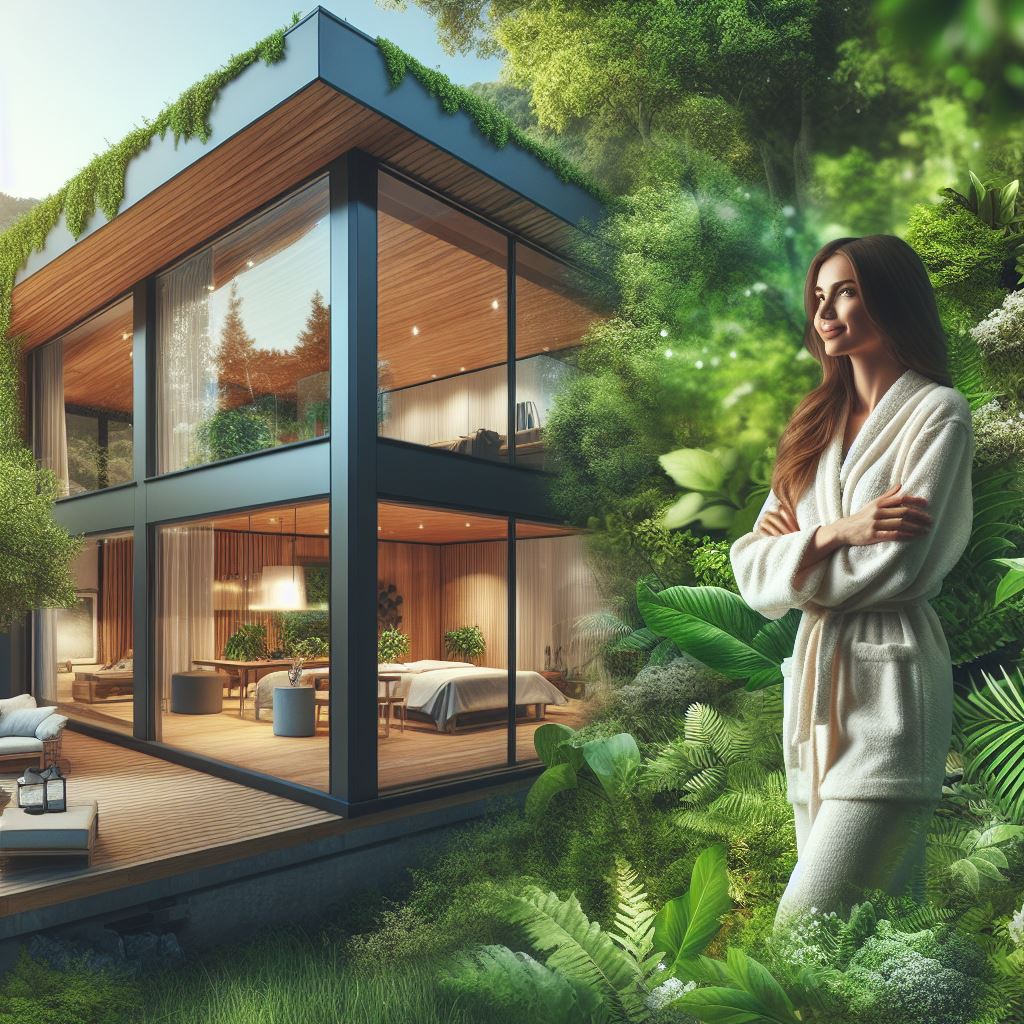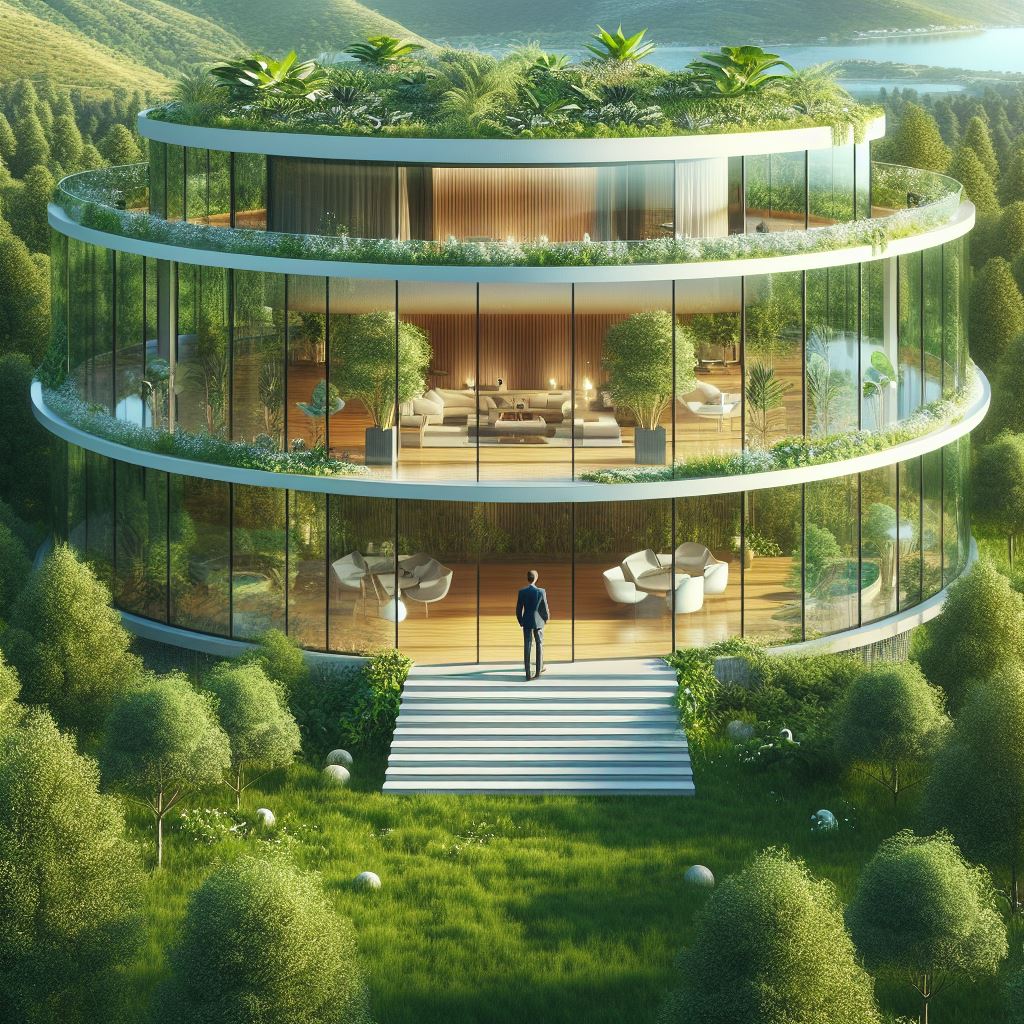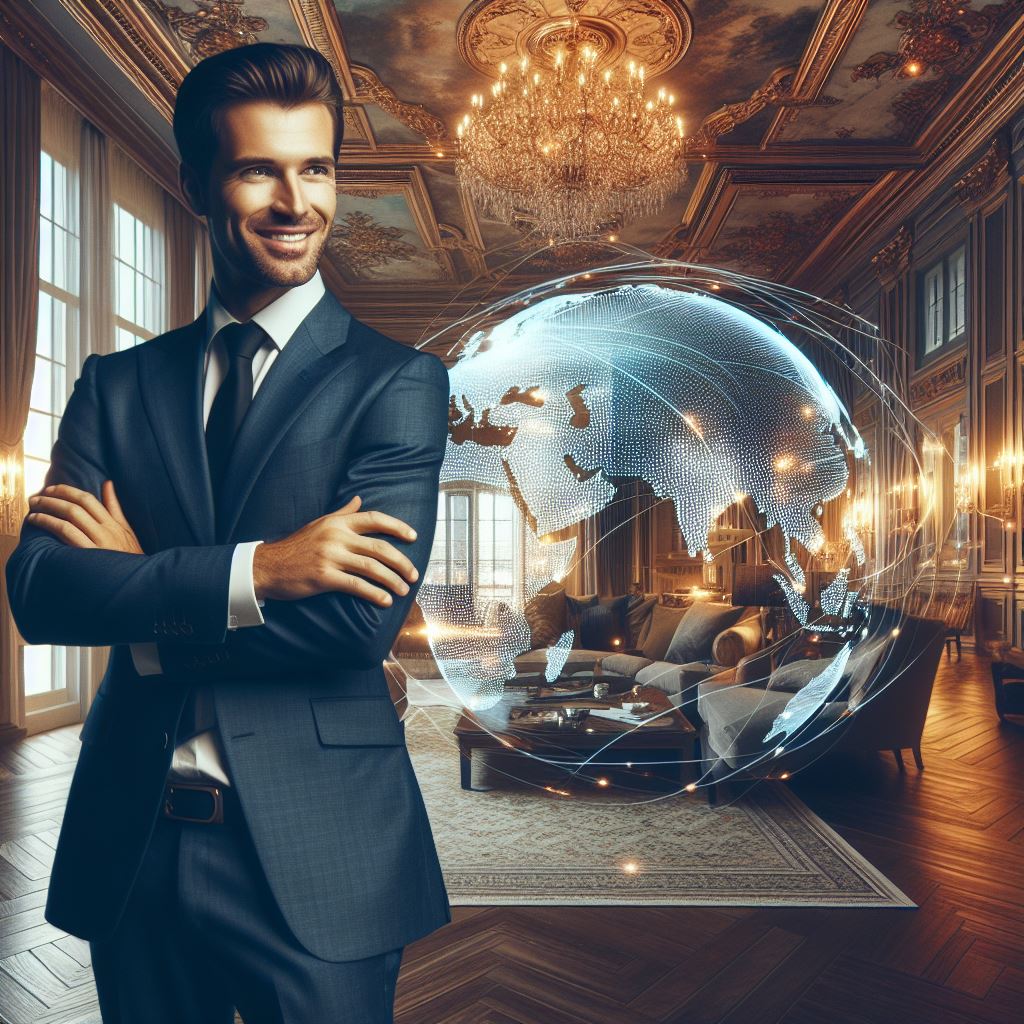Introduction
In the hustle of contemporary life, a profound longing for connection to nature lingers.
Surrounded by steel and glass, individuals seek solace in eco-conscious luxury living.
The juxtaposition of opulence and environmental responsibility sparks a revolution in architectural design.
Nature, often seen as a muse, inspires a new wave of living spaces.
From rooftop gardens to bio-walls, architects weave the outdoors seamlessly into the fabric of luxury interiors.
This symbiotic relationship transforms mere homes into sanctuaries where inhabitants thrive amid greenery.
Nurturing this concept extends beyond aesthetics.
Cutting-edge technologies harmonize with sustainable practices to create energy-efficient havens.
Solar panels adorn rooftops, harnessing the power of the sun, while rainwater harvesting systems replenish the earth.
The result is a residence that not only indulges in luxury but also nurtures the planet.
Beyond the physical, the psychology of eco-luxury living takes center stage.
Nature’s calming influence, replicated within these spaces, fosters mental well-being.
Floor-to-ceiling windows invite natural light, creating a connection to the rhythm of the day.
Each room becomes a canvas painted with the colors of the changing seasons.
As we embark on this exploration of Eco Luxury Living Spaces, envision a realm where opulence meets responsibility.
Transform Your Real Estate Decisions
Unlock personalized real estate insights crafted just for you. Get actionable advice designed to amplify your success.
Get StartedNature and Nurture intertwine, giving rise to homes that embrace the environment, embodying a sustainable luxury lifestyle.
Join us on this journey into the heart of a harmonious coexistence between lavish living and ecological mindfulness.
Definition of Eco Luxury Living Spaces
Eco luxury living spaces refer to homes or living environments that are designed and built with a strong focus on environmental sustainability.
These spaces integrate the principles of eco-consciousness and luxury, combining both elements seamlessly to create a luxurious living experience that is also environmentally friendly.
The concept of eco luxury living spaces
Eco luxury living spaces prioritize sustainable materials and renewable energy sources to minimize their ecological impact.
These spaces often incorporate green building practices, such as efficient insulation, solar panels, and rainwater harvesting systems.
They aim to reduce energy consumption, carbon emissions, and waste production throughout their lifespan.
Eco luxury living spaces also promote a connection with nature, integrating natural elements into the design, such as organic shapes and biophilic elements.
They prioritize indoor air quality, using non-toxic materials, natural ventilation, and air purification systems.
The concept extends beyond the physical structure, encompassing the entire living experience, including eco-friendly furniture, appliances, and amenities.
Eco-consciousness is reflected in the use of sustainable fabrics, recycled materials, and ethical production methods for furnishings and decor.
Eco luxury living spaces often incorporate smart home technology, enabling residents to monitor and control energy usage and systems remotely.
These spaces provide a unique combination of modern luxury and sustainable living, catering to individuals who value both environmental responsibility and high-end living.
Combination of sustainability and luxury
By combining sustainability with luxury, eco luxury living spaces offer a guilt-free indulgence for environmentally conscious individuals.
Showcase Your Real Estate Business
Publish your company profile on our blog for just $200. Gain instant exposure and connect with a dedicated audience of real estate professionals and enthusiasts.
Publish Your ProfileThey demonstrate that sustainable living does not have to mean compromising on comfort or aesthetic appeal.
The use of high-quality, eco-friendly materials and innovative design approaches creates a sense of luxury within these spaces.
Eco luxury living spaces embrace the concept of slow and mindful living, encouraging residents to live in harmony with the natural surroundings.
These spaces often feature expansive windows, allowing for the integration of natural light, scenic views, and a strong indoor-outdoor connection.
The combination of sustainability and luxury fosters a sense of well-being and promotes a healthier lifestyle for the inhabitants.
Eco luxury living spaces demonstrate that eco-consciousness can be intrinsically linked to elegance, sophistication, and opulence.
They cater to individuals seeking a refined living experience that aligns with their values of sustainability and responsible consumption.
With the increasing demand for eco-friendly alternatives, the concept of eco luxury living spaces has gained significant popularity in recent years.
Developers and designers are embracing this trend, incorporating green features and sustainable practices into high-end residential projects.
In essence, eco luxury living spaces offer a harmonious blend of sustainability and luxury, providing individuals with a sophisticated living experience that is also environmentally conscious.
These spaces prioritize the use of sustainable materials, energy-efficient technologies, and smart home systems.
By combining elegant design and environmental responsibility, eco luxury living spaces represent the future of luxurious living.
Read: Global Elite Homes: How US Buyers Respond
Importance of Eco-friendly Living
The growing concern for the environment
Eco-friendly living is no longer a mere trend; it has become a necessity for our planet’s survival.
The increasing concern for the environment and the need for sustainable practices in housing highlight the importance of embracing eco-friendly living spaces.
Individuals are recognizing the adverse impacts of human activities on the environment and are becoming more conscious of their responsibility to protect it.
Communities and governments are taking action to address environmental challenges through various initiatives.
The need for sustainable practices in housing
When it comes to housing, traditional construction practices have been a significant contributor to environmental degradation.
These practices often involve the use of non-renewable resources and produce substantial greenhouse gas emissions.
However, sustainable practices in housing can significantly reduce energy consumption, waste generation, and overall environmental impact.
Embracing eco-friendly building standards not only leads to long-term cost savings but also improves the quality of life for individuals.
Benefits of eco-friendly living for individuals and the planet
Eco-friendly living offers a range of benefits for both individuals and the planet.
By choosing eco-friendly living spaces, individuals create healthier environments that minimize exposure to harmful chemicals, improve indoor air quality, and provide better thermal comfort.
The use of renewable energy sources reduces reliance on fossil fuels, thereby mitigating climate change.
Efficient water conservation practices help address the strain on water resources.
Additionally, opting for sustainable materials and minimizing waste contributes to a circular economy.
Furthermore, eco-friendly living promotes a sense of community and social responsibility.
It encourages individuals to inspire others and drive positive change.
By preserving natural resources, present and future generations can enjoy a thriving and diverse planet.
Adopting sustainable practices collectively creates a cleaner and more sustainable world for everyone.
Showcase Your Real Estate Business
Publish your company profile on our blog for just $200. Gain instant exposure and connect with a dedicated audience of real estate professionals and enthusiasts.
Publish Your ProfileIn fact, the growing concern for the environment and the need for sustainable practices in housing emphasize the vital importance of eco-friendly living.
It is imperative to recognize the benefits of eco-friendly living for individuals and the planet.
By embracing sustainable practices, individuals contribute to a healthier lifestyle, reduced environmental impact, and inspire positive change.
Together, we can create a more sustainable future for generations to come.
Read: Eco Opulence: Luxury Homes Redefining Green
Integration of Nature in Eco Luxury Living Spaces
The inclusion of natural elements in interior design
In eco luxury living spaces, the integration of natural elements in interior design plays a crucial role.
Incorporating these elements creates a harmonious connection between humans and the environment.
Firstly, incorporating natural textures and patterns in furniture and decor can create a sense of tranquility.
For instance, using bamboo or rattan chairs brings an organic touch to the living space.
Moreover, integrating natural colors such as earth tones can enhance the overall ambiance.
Shades of green, brown, and beige mimic nature and promote a soothing atmosphere.
Additionally, incorporating natural elements like stones and pebbles in the flooring or as decorative accents can add a unique touch.
These elements not only offer aesthetic appeal but also connect occupants to the natural world.
Use of organic materials, such as wood and stone
The use of organic materials is a significant aspect of eco luxury living spaces.
Wood and stone, in particular, play a vital role in creating a sustainable and eco-friendly environment.
Wood, a renewable resource, adds warmth and character to the living space.
It can be used for furniture, flooring, and even as wall paneling.
Choosing sustainably sourced wood ensures minimal impact on the environment.
Stone, on the other hand, brings a sense of timelessness and durability to the living space.
By using natural and locally sourced stone, one can minimize transportation and reduce the carbon footprint.
Incorporation of natural light and indoor plants
In eco luxury living spaces, the incorporation of natural light and indoor plants is imperative.
These elements not only enhance the aesthetics but also contribute to the well-being of occupants.
Natural light, streaming through large windows or skylights, creates a sense of openness and spaciousness.
It not only reduces the need for artificial lighting but also provides various health benefits, such as improved mood and increased productivity.
Furthermore, indoor plants are an integral part of eco luxury living.
They not only add a touch of greenery but also improve air quality by filtering pollutants.
Incorporating plant walls or creating dedicated plant corners creates a serene and healthy indoor environment.
In short, integrating nature in eco luxury living spaces is essential for creating a holistic and sustainable environment.
By exploring the inclusion of natural elements in interior design, using organic materials like wood and stone, and highlighting the incorporation of natural light and indoor plants, occupants can experience the beauty of nature within their living spaces.
Such integration not only enhances the visual appeal but also promotes a sense of well-being and connectivity with the environment.
Showcase Your Real Estate Business
Publish your company profile on our blog for just $200. Gain instant exposure and connect with a dedicated audience of real estate professionals and enthusiasts.
Publish Your ProfileSustainable Features of Eco Luxury Living Spaces
Energy-Efficient Appliances and Systems
Energy-efficient appliances reduce energy consumption and lower electricity bills.
Smart thermostats and programmable timers optimize the use of heating and cooling systems.
Insulated walls and roofs improve energy efficiency by minimizing heat transfer.
LED lighting systems consume less energy and have a longer lifespan than traditional bulbs.
Ventilation systems with heat recovery eliminate the need for excessive heating or cooling.
Renewable Energy Sources
Solar panels convert sunlight into electricity, providing a clean and renewable energy source.
Wind turbines harness wind power and generate electricity without producing any harmful emissions.
Geothermal systems utilize the Earth’s heat to provide heating and cooling for the living space.
Hydroelectric power systems use flowing water to generate electricity in an eco-friendly manner.
Biomass boilers burn organic materials to produce heat and hot water sustainably.
Water-Saving Fixtures and Smart Home Technologies
Low-flow faucets and showerheads reduce water consumption without sacrificing water pressure.
Dual-flush toilets offer different flushing options to conserve water based on the waste type.
Rainwater harvesting systems collect rainwater for non-potable uses like irrigation or toilet flushing.
Smart irrigation systems use weather data and soil moisture sensors to optimize water usage.
Water recycling systems treat and reuse greywater from sinks, showers, and laundry machines.
Eco-conscious Building Materials and Construction Methods
In crafting sustainable luxury living spaces, the choice of materials and construction methods becomes paramount.
Importance of using eco-friendly materials
Selecting materials with a minimal environmental footprint is crucial.
Eco-friendly options, like reclaimed wood and recycled steel, embody responsible choices.
Opting for sustainable materials not only lessens the impact on our ecosystems but also promotes resource conservation.
Bamboo, for instance, is a rapidly renewable resource, making it an eco-conscious flooring and furniture option.
Beyond mere aesthetics, eco-friendly materials contribute to indoor air quality, ensuring a healthier living environment.
Volatile organic compounds (VOCs) commonly found in conventional building materials can be replaced with low-emission alternatives.
Sustainable construction practices
Green construction techniques play a pivotal role in creating eco-luxury living spaces.
Integrating energy-efficient designs, such as passive solar heating and cooling, optimizes natural resources.
It reduces reliance on artificial climate control, promoting a harmonious blend with nature.
Water conservation becomes paramount in sustainable construction.
Implementing rainwater harvesting systems and low-flow fixtures ensures responsible water usage without compromising luxury.
Architectural innovation embraces green roofs and walls, incorporating vegetation into structures.
These not only enhance aesthetics but also provide insulation, reducing energy consumption.
Incorporating recycled materials into construction not only minimizes waste but also adds character to the living space.
Showcase Your Real Estate Business
Publish your company profile on our blog for just $200. Gain instant exposure and connect with a dedicated audience of real estate professionals and enthusiasts.
Publish Your ProfileSalvaged bricks, repurposed windows, and recycled glass countertops can redefine luxury with a conscience.
In general, the synergy of eco-conscious building materials and sustainable construction practices propels the ethos of eco-luxury living.
Every choice made in construction echoes a commitment to a greener, more sustainable future.
From the foundation to the finishing touches, each element harmonizes with nature, embodying the essence of responsible luxury living.
Read: International Luxury: Shifts Affecting US Market

Benefits of Living in Eco Luxury Living Spaces
Positive Impact on Residents’ Health and Well-being
Living in eco luxury living spaces offers numerous benefits that positively impact residents’ health and well-being.
- Improved Air Quality: These living spaces prioritize proper ventilation and use air filtration systems, resulting in cleaner and fresher indoor air quality.
- Reduced Exposure to Toxins: Eco-friendly materials and furniture minimize the presence of harmful toxins, ensuring a healthier living environment.
- Natural Light: Ample windows and open floor plans allow for maximum natural light, reducing the risk of vitamin D deficiency and promoting mental well-being.
- Noise Reduction: Innovative soundproofing techniques and thoughtful design minimize noise pollution, leading to better sleep quality and overall tranquility.
- Biophilic Design: Incorporating elements of nature, such as indoor plants and natural materials, creates a calming and rejuvenating atmosphere that promotes stress reduction.
- Active Lifestyle: Eco luxury living spaces often feature amenities like gyms, walking paths, and cycling tracks, encouraging residents to lead an active and healthy lifestyle.
Potential Energy and Cost Savings
Apart from the health benefits, living in eco luxury living spaces offers substantial energy and cost savings.
- Energy Efficiency: These living spaces employ energy-efficient appliances, LED lighting, and smart home technologies, significantly reducing energy consumption.
- Renewable Energy Sources: Incorporating solar panels and wind turbines allows residents to generate their own electricity and decrease dependence on the grid.
- Reduced Utility Bills: Energy-efficient designs and renewable energy sources contribute to lower monthly utility bills, offering long-term cost savings.
- Water Conservation: Eco luxury living spaces often incorporate advanced water-saving technologies, such as rainwater harvesting and efficient irrigation systems, reducing water consumption and costs.
- Waste Management: Implementing waste management systems, including recycling programs and composting, helps residents minimize waste and reduces waste management costs.
Contribution to Environmental Conservation
Living in eco luxury living spaces aligns with the principles of environmental conservation.
- Sustainable Materials: These living spaces use sustainable building materials, such as bamboo and reclaimed wood, reducing the demand for virgin resources.
- Green Spaces: Incorporating green rooftops and gardens not only enhances the aesthetics but also provides habitats for wildlife and promotes urban biodiversity.
- Reduced Carbon Footprint: Energy-efficient designs and renewable energy sources reduce carbon emissions, mitigating the negative impact on the environment.
- Rainwater Management: Implementing rainwater harvesting systems reduces pressure on municipal water sources and contributes to sustainable water management.
- Community Education: Eco luxury living spaces often organize educational programs and workshops, fostering awareness and encouraging sustainable practices within the community.
In review, living in eco luxury living spaces offers a host of benefits, including improved health and well-being, energy and cost savings, and contribution to environmental conservation.
These sustainable living spaces not only provide luxurious amenities but also prioritize the long-term welfare of residents and the planet.
Read: Global Luxury Property: US Buyers’ Preferences
Examples of Successful Eco Luxury Living Spaces
Case studies or examples of eco luxury housing projects
- The Visionaire in New York City: This LEED Platinum certified residential building features eco-friendly materials, energy-efficient systems, and green roofs.
- One Central Park in Sydney: This stunning development boasts vertical gardens, solar panels, and a water-recycling system, setting the standard for sustainable living.
- Tree House in Bangalore: Built with recycled materials and utilizing rainwater harvesting, this eco luxury home showcases the perfect blend of nature and modern design.
- The Edge in Amsterdam: This futuristic office building utilizes solar panels, energy-efficient lighting, and intelligent climate control, creating a truly eco-friendly workspace.
Success stories and positive feedback from residents
Sarah Johnson, a resident of The Visionaire, expresses her joy in living in a space that promotes sustainability while providing luxury and comfort.
Mark and Lisa Thompson, owners of a unit in One Central Park, appreciate the abundance of natural light and the breathtaking views of the surrounding greenery.
Rajesh Kumar, the proud owner of Tree House, shares how his eco-friendly home not only reduces his carbon footprint but also creates a serene and healthy living environment.
The employees at The Edge rave about the building’s innovative features, such as the intelligent climate control system that adjusts temperature and lighting based on individual preferences.
By highlighting these examples and success stories, it becomes evident that eco luxury living spaces can be both sustainable and luxurious.
These projects demonstrate the possibility of creating harmonious living environments that prioritize environmental responsibility without compromising on comfort and elegance.
They serve as inspiration for future developments and encourage individuals to embrace eco-friendly living.
The case studies showcase the integration of eco-friendly technologies and design elements that contribute to lowering energy consumption and minimizing the impact on the environment.
From energy-efficient systems to green roofs and rainwater harvesting, these projects illustrate the seamless blending of nature and luxurious living.
Moreover, the positive feedback from residents emphasizes the satisfaction and well-being experienced in these eco luxury living spaces.
The residents not only appreciate the eco-friendly features but also witness the positive impact on their daily lives.
Reduced utility bills, improved air quality, and a deeper connection with nature are among the many benefits mentioned by these individuals.
In a nutshell, the examples of successful eco luxury living spaces presented above demonstrate that sustainable living can coexist with luxury and comfort.
These case studies and success stories inspire sustainable practices, highlight the importance of incorporating eco-friendly features, and prove that nature and nurture can harmoniously unite in the world of luxury living.
Let these examples serve as a reminder that promoting sustainability in our living spaces can lead to a greener future for all.
Challenges and Future Outlook
Obstacles faced in promoting eco luxury living spaces
- The high cost of implementing sustainable technologies and materials.
- Limited availability of eco-friendly resources and materials.
- Resistance from traditional construction industries and stakeholders.
- Lack of awareness and understanding among potential buyers.
- Regulatory hurdles and inconsistent government policies.
- Difficulty in finding skilled professionals with expertise in eco-friendly construction.
- Perception that eco luxury living spaces compromise on comfort and luxury.
- The challenge of integrating sustainable design seamlessly into existing urban landscapes.
- The need for continuous education and updates in rapidly evolving green technologies.
- Overcoming the misconception that eco-friendly living spaces are restrictive and inconvenient.
Ongoing efforts and innovations in the field
- Introduction of sustainable housing certification programs like LEED and BREEAM.
- Increased collaboration between architects, designers, and sustainability experts.
- Integration of renewable energy sources like solar panels and wind turbines.
- Exploration of new materials with low carbon footprint, such as bamboo and recycled plastics.
- Implementation of smart technologies for energy management and efficient resource utilization.
- Use of green roofs and vertical gardens to enhance biodiversity and reduce heat island effect.
- Adoption of water-saving techniques like rainwater harvesting and greywater recycling systems.
- Promotion of green building practices through incentives and tax benefits.
- Development of sustainable construction materials, such as eco-concrete and recycled steel.
- Continued research and development in sustainable design and construction processes.
A positive outlook for the future of eco luxury living spaces
The challenges faced in promoting eco luxury living spaces are gradually being overcome, and the future looks promising.
As society becomes more aware of the impact of climate change and the importance of sustainability, there is a growing demand for environmentally friendly luxury living spaces.
The obstacles, such as high costs and limited resources, are being addressed by ongoing efforts and innovations in the field.
The collaboration between experts from different disciplines is resulting in the development of sustainable technologies and materials that are both luxurious and eco-friendly.
Showcase Your Real Estate Business
Publish your company profile on our blog for just $200. Gain instant exposure and connect with a dedicated audience of real estate professionals and enthusiasts.
Publish Your ProfileCertification programs like LEED and BREEAM provide a standardized framework for evaluating and recognizing sustainable housing, creating a benchmark for future projects.
With the advent of smart technologies, it is becoming easier to monitor and manage energy consumption, leading to more efficient resource utilization.
Green building practices are being incentivized by governments, encouraging developers and buyers to choose eco-friendly options.
Furthermore, the perception that eco luxury living spaces compromise on comfort and luxury is changing.
Architects and designers are successfully integrating sustainable design principles into their projects without compromising on aesthetics or functionality.
The increasing availability of sustainable construction materials and the development of alternative energy sources are making eco luxury living spaces more accessible and practical.
As these technologies become more mainstream and cost-effective, their adoption is likely to increase.
Overall, the future of eco luxury living spaces is bright.
The challenges faced today are being met with determination and innovation.
As awareness and demand continue to grow, we can expect to see a significant increase in the availability and affordability of eco-friendly luxury living spaces.
Conclusion
Recap the main points discussed in the blog post
In our exploration of eco luxury living spaces, we’ve delved into the harmonious blend of nature and nurture.
These spaces seamlessly integrate opulence with sustainability, redefining modern living.
From green roofs to energy-efficient systems, these homes exemplify a commitment to environmental responsibility.
Architects and designers meticulously craft each space, considering not only aesthetics but also the ecological impact.
The use of eco-friendly materials ensures that luxury doesn’t come at the expense of the planet.
Bamboo flooring, reclaimed wood, and recycled glass are not just design choices; they’re statements about a conscientious lifestyle.
Encouraging readers to consider the benefits of eco luxury living spaces
As readers, envision the benefits: reduced carbon footprint, lower utility bills, and an overall healthier living environment.
Embrace the tranquility of spaces designed to coexist with the natural world while indulging in the lap of luxury.
Consider the long-term impact on your well-being and the environment.
These living spaces offer more than just a lavish lifestyle; they provide a chance to contribute to a sustainable future.
As we conclude, ask yourself: Can luxury coexist with nature without compromise? The answer lies in the choices we make today.
oin the movement towards eco luxury living — where opulence meets responsibility. How will you redefine your living space?




